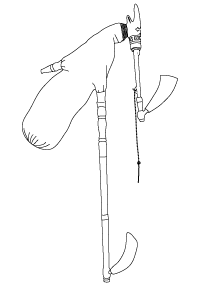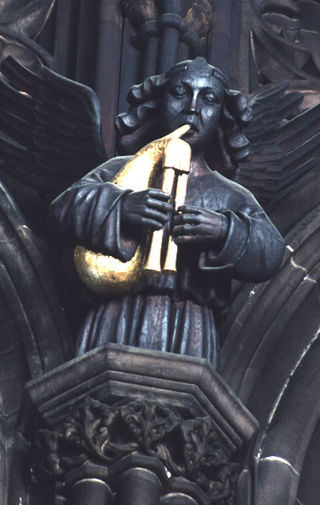Related Research Articles

Bagpipes are a woodwind instrument using enclosed reeds fed from a constant reservoir of air in the form of a bag. The Great Highland bagpipes are well known, but people have played bagpipes for centuries throughout large parts of Europe, Northern Africa, Western Asia, around the Persian Gulf and northern parts of South Asia.

Robert Lowth was a Bishop of the Church of England, Oxford Professor of Poetry and the author of one of the most influential textbooks of English grammar.

The uilleann pipes are the characteristic national bagpipe of Ireland. Earlier known in English as "union pipes", their current name is a partial translation of the Irish language terms píobaí uilleann, from their method of inflation. There is no historical record of the name or use of the term uilleann pipes before the 20th century. It was an invention of Grattan Flood and the name stuck. People mistook the term 'union' to refer to the 1800 Act of Union; this is incorrect as Breandán Breathnach points out that a poem published in 1796 uses the term 'union'.

The great Highland bagpipe is a type of bagpipe native to Scotland, and the Scottish analogue to the great Irish warpipes. It has acquired widespread recognition through its usage in the British military and in pipe bands throughout the world.

The Northumbrian smallpipes are bellows-blown bagpipes from North East England, where they have been an important factor in the local musical culture for more than 250 years. The family of the Duke of Northumberland have had an official piper for over 250 years. The Northumbrian Pipers' Society was founded in 1928, to encourage the playing of the instrument and its music; Although there were so few players at times during the last century that some feared the tradition would die out, there are many players and makers of the instrument nowadays, and the Society has played a large role in this revival. In more recent times the Mayor of Gateshead and the Lord Mayor of Newcastle have both established a tradition of appointing official Northumbrian pipers.
Drone music, drone-based music, or simply drone, is a minimalist genre that emphasizes the use of sustained sounds, notes, or tone clusters – called drones. It is typically characterized by lengthy audio programs with relatively slight harmonic variations throughout each piece. La Monte Young, one of its 1960s originators, defined it in 2000 as "the sustained tone branch of minimalism". Elements of drone music have been incorporated in diverse genres such as rock, ambient, and techno.

The Hungarian duda is the traditional bagpipe of Hungary. It is an example of a group of bagpipes called Medio-Carparthian bagpipes.

A pipe is a tubular wind instrument in general, or various specific wind instruments. The word is an onomatopoeia, and comes from the tone which can resemble that of a bird chirping.
Cornish bagpipes are the forms of bagpipes once common in Cornwall in the 19th century. Bagpipes and pipes are mentioned in Cornish documentary sources from c.1150 to 1830 and bagpipes are present in Cornish iconography from the 15th and 16th centuries.

Welsh bagpipes The names in Welsh refer specifically to a bagpipe. A related instrument is one type of bagpipe chanter, which when played without the bag and drone is called a pibgorn (English:hornpipe). The generic term pibau (pipes) which covers all woodwind instruments is also used. They have been played, documented, represented and described in Wales since the fourteenth century. A piper in Welsh is called a pibydd or a pibgodwr.

The pibgorn is a Welsh species of idioglot reed aerophone. The name translates literally as "pipe-horn". It is also historically known as cornicyll and pib-corn. It utilises a single reed, cut from elder or reed, like that found in the drone of a bagpipe, which is an early form of the modern clarinet reed. The single chambered body of the elder pipe has a naturally occurring parallel bore, into which are drilled six small finger-holes and a thumb-hole giving a diatonic compass of an octave. The body of the instrument is traditionally carved from a single piece of wood or bone. Playable, extant historical examples in the Museum of Welsh Life have bodies cut and shaped of elder. Another, unplayable instrument at the Museum, possibly of a later date, is made from the leg bone of an unspecified ungulate. Contemporary instruments are turned and bored from a variety of fruitwoods, or exotic hardwoods; or turned from, or moulded in plastics. The reed is protected by a reed-cap or stock of cow-horn. The bell is shaped from a section of cow-horn which serves to amplify the sound. The pibgorn may be attached to a bag, with the additional possibility of a drone, which is then called pibau cwd; or played directly with the mouth via the reed-cap.

The hornpipe can refer to a specific instrument or a class of woodwind instruments consisting of a single reed, a small diameter melody pipe with finger holes and a bell traditionally made from animal horn. Additionally, a reed cap of animal horn may be placed around the reed to contain the breath and allow circular breathing for constant play, although in many cases the reed is placed directly in the mouth. It was also known as the pibcorn, pibgorn, or piccorn. One rare Scottish example, called the stock-and-horn, is referred to by Robert Burns among others. Other hornpipes include the Spanish gaita gastoreña, the Basque alboka and the Eastern European zhaleika. When joined with a bag, Baines refers to the instruments as "bag-hornpipes".

When bagpipes arrived in England is unknown, there is some evidence to suggest Anglo-Saxon times, however the oldest confirmed proof of the existence of bagpipes anywhere in the world comes from three separate sources in the 13th century. Two of them English; the Tenison Marginalie Psalter from Westminster and an entry into the accounts books of Edward the I of England recording the purchase of a set of bagpipes. The third from the Cantigas Del Santa Maria published in Spain. From the 14th century onwards, bagpipes start to appear in the historical records of European countries, however half the mentions come from England suggesting Bagpipes were more common in England.
Anthony Cuthbert Baines (1912–1997) was an English organologist who produced a wide variety of works on the history of musical instruments, and was a founding member of the Galpin Society.
It is unclear whether Lincolnshire bagpipes refer to a specific type of pipes native to Lincolnshire, England, or to the popularity of a more general form of pipes in the region. Written records of bagpipes being associated with Lincolnshire date back to 1407, but it is difficult to find certain proof that any regional variation of the bagpipe existed which was peculiar to Lincolnshire. Despite the lack of evidence for a uniquely local instrument, it is clear that the bagpipe was enjoyed by the people of Lincolnshire.
The pilai is a type of Finnish bagpipe, described as "primitive", and as being similar to the Russian volynka. A 1796 texts describes it as "the last of the Russian wind instruments" but noted it "appertains properly to the Finns". The same text describes it as being made with a mouthpiece, two pipes, and an undressed goatskin.
The mashak is a type of bagpipe found in Northern India, Uttarakhand, Sudurpaschim Province of Nepal and parts of Pakistan and Afghanistan. The pipe was associated with weddings and festive occasions. In India it is historically found in Kumaon and Garhwal in Uttarakhand, Rajasthan and Uttar Pradesh. This bagpipe uses single reeds, and can be played either as a drone or as a melody instrument.

Manton is a village and civil parish in North Lincolnshire, England. The population of the civil parish at the 2011 census was 123. The village is situated just south from the town of Scunthorpe, and about 6 miles (10 km) south-west from the town of Brigg. The parish includes the hamlet of Cleatham. Cleatham was a civil parish between 1866 and 1936.
William Alfred Cocks (1892-1971) was a master clock maker from Ryton, near Newcastle upon Tyne. He had a lifelong interest in the history and culture of the North-east of England, and particularly in the Northumbrian smallpipes and half-long pipes. He assembled a large collection of historic bagpipes, their music, and related materials, which forms the core of the collection now housed at the Morpeth Chantry Bagpipe Museum. He was elected to the Society of Antiquaries of Newcastle upon Tyne in 1920, remaining a member until his death. In 1928, he was one of the earliest members of the Northumbrian Pipers' Society, being elected one of the technical advisers, with responsibility for smallpipes. He became a Vice-President of the Society in 1938. When an exhibition of historic pipes was held in the Black Gate Museum in 1961, most of the exhibits were from Cocks's collection.
The oaten pipe are a rare type of English and Scottish reedpipe made from the straw of the oat plant or similar natural materials, commonly associated with pastoral culture. An 1898 dictionary described the instrument as "The simplest form of a reed pipe, a straw with a strip cut to form the reed, at the end closed by the knot". Similar instruments are made across a variety of cultures, while the specific term "oaten pipe" is found in English literature, connoting pastoral imagery.
References
- ↑ A commentator the 1881 Oxford Journals' Notes and queries noted that Hunsley played the pipes up until shortly before his death, which occurred "between twenty and thirty years ago."
- ↑ Oxford Journals (Firm) (1881). Notes and queries. Oxford University Press. pp. 95–. Retrieved 16 May 2011.
- ↑ Lincolnshire famed for its sausages, flat landscape, cathedral and... bagpipes? . Lincolnshire Echo, 30 December 2010
- ↑ Christopher R. Wilson, Michela Calore. Music in Shakespeare: a dictionary. Continuum International Publishing Group, 2005. ISBN 0-8264-7846-8, ISBN 978-0-8264-7846-7. Pg 33
- ↑ Anthony Baines (1979). Bagpipes. Pitt Rivers Museum. p. 134. Retrieved 16 May 2011.
- ↑ Binnall, P.B.G. "A Man of Might" in FOLKLORE, Vol.52, pp.52-74, 1942